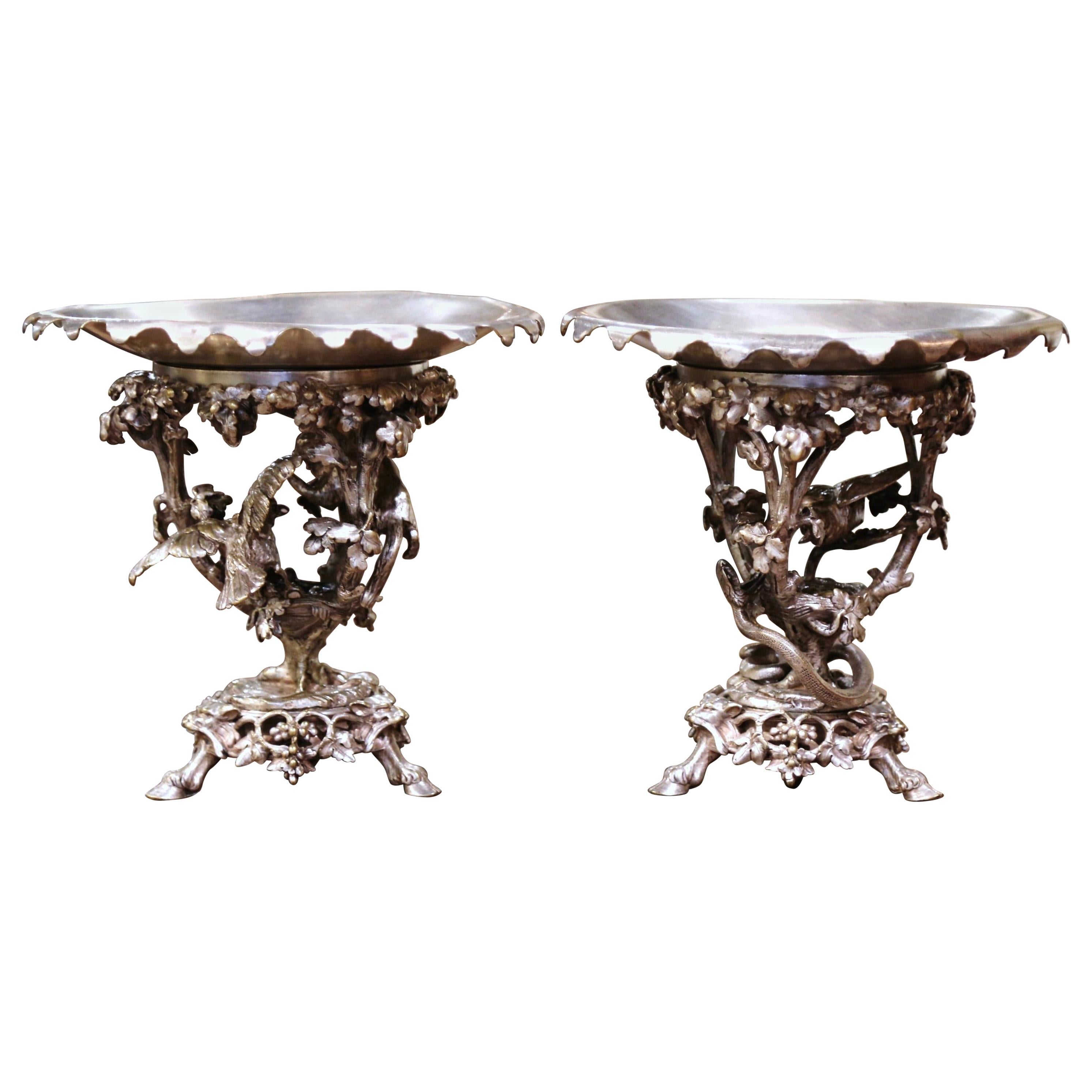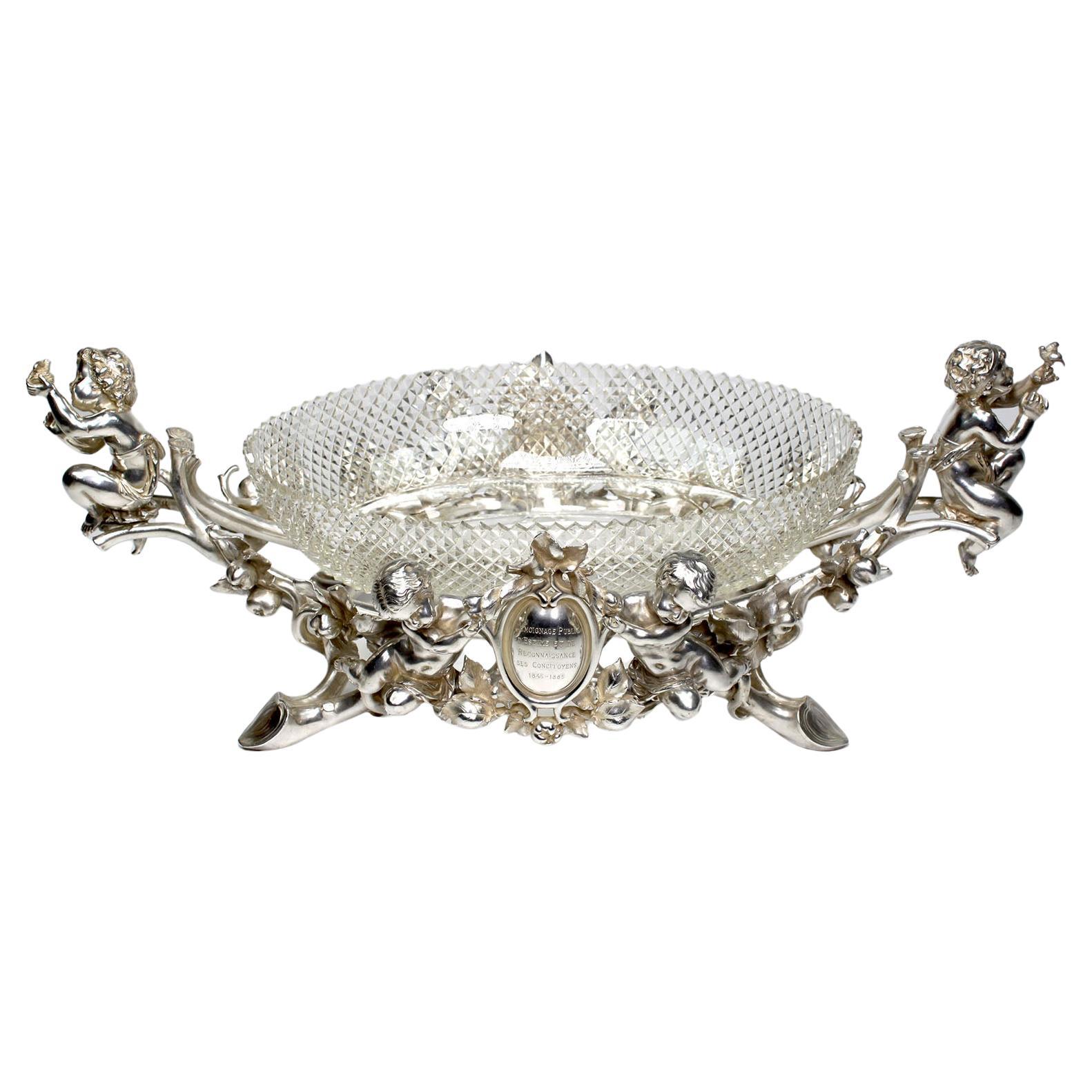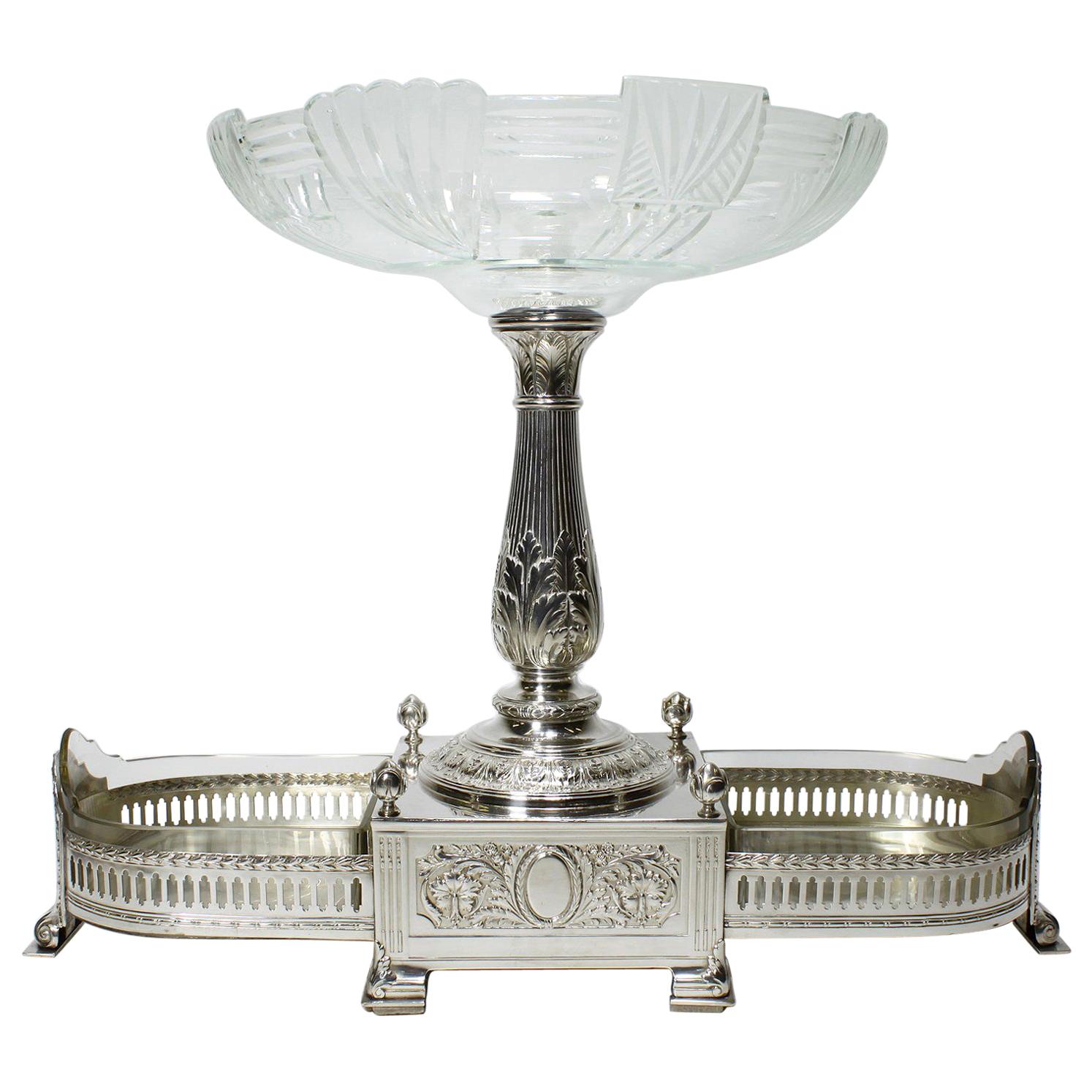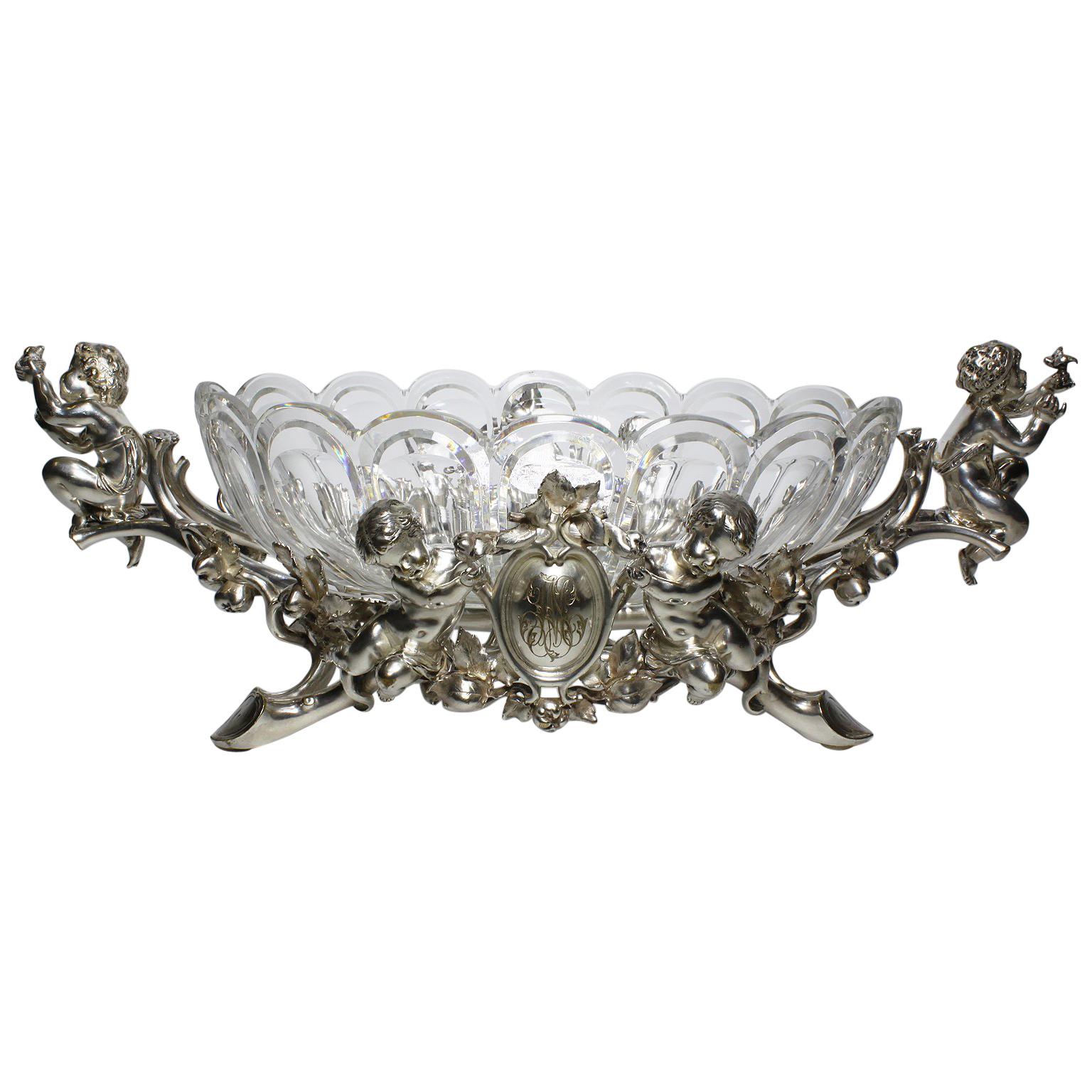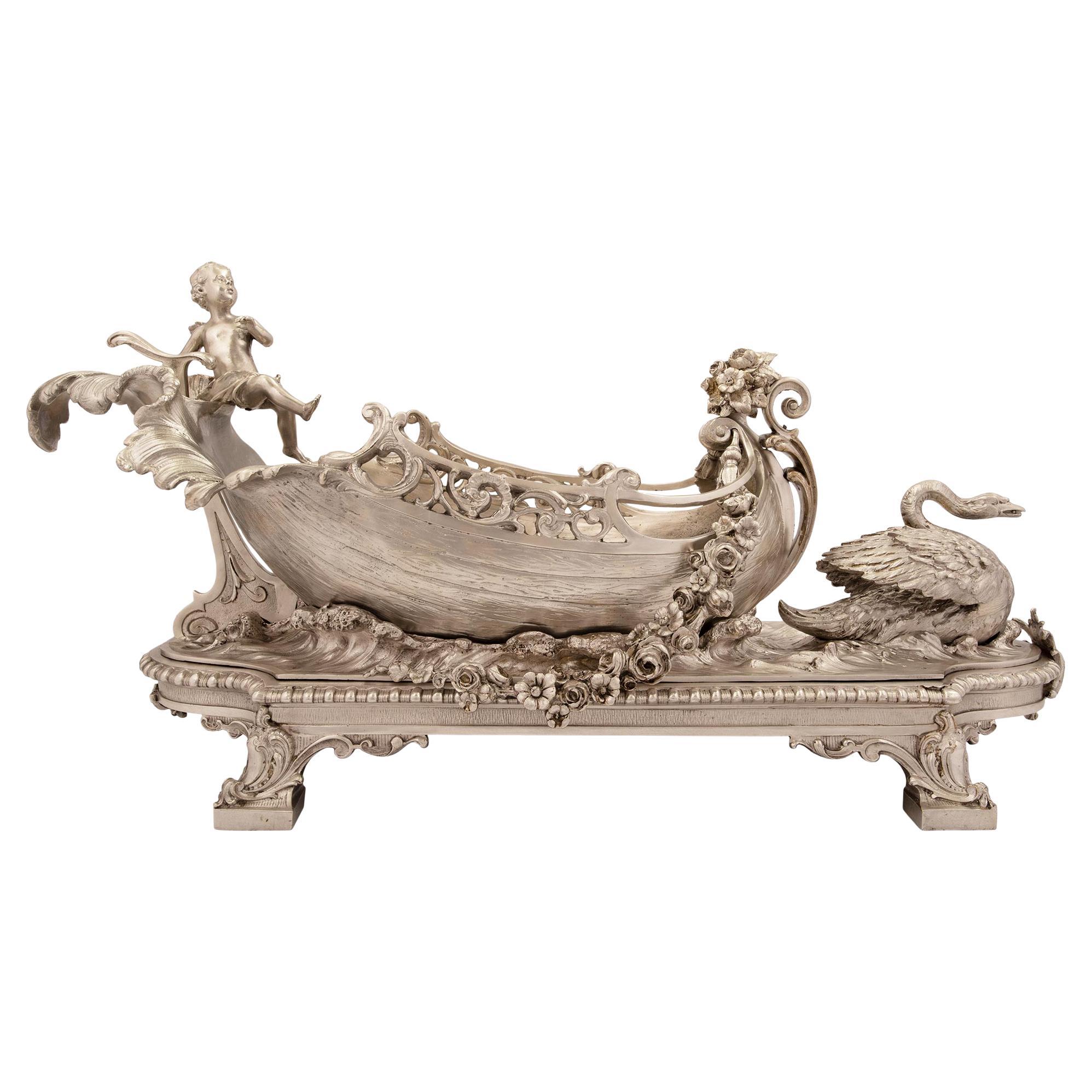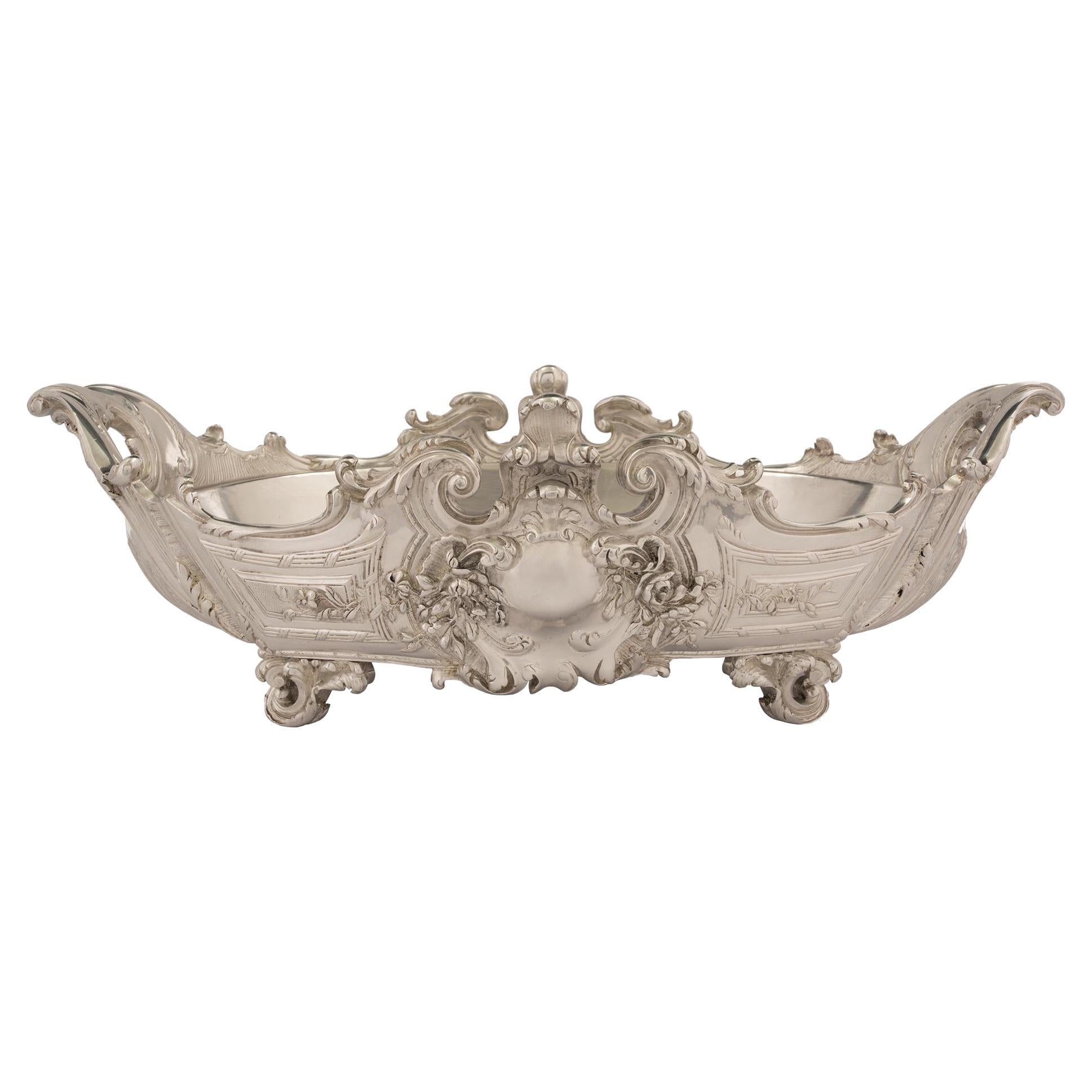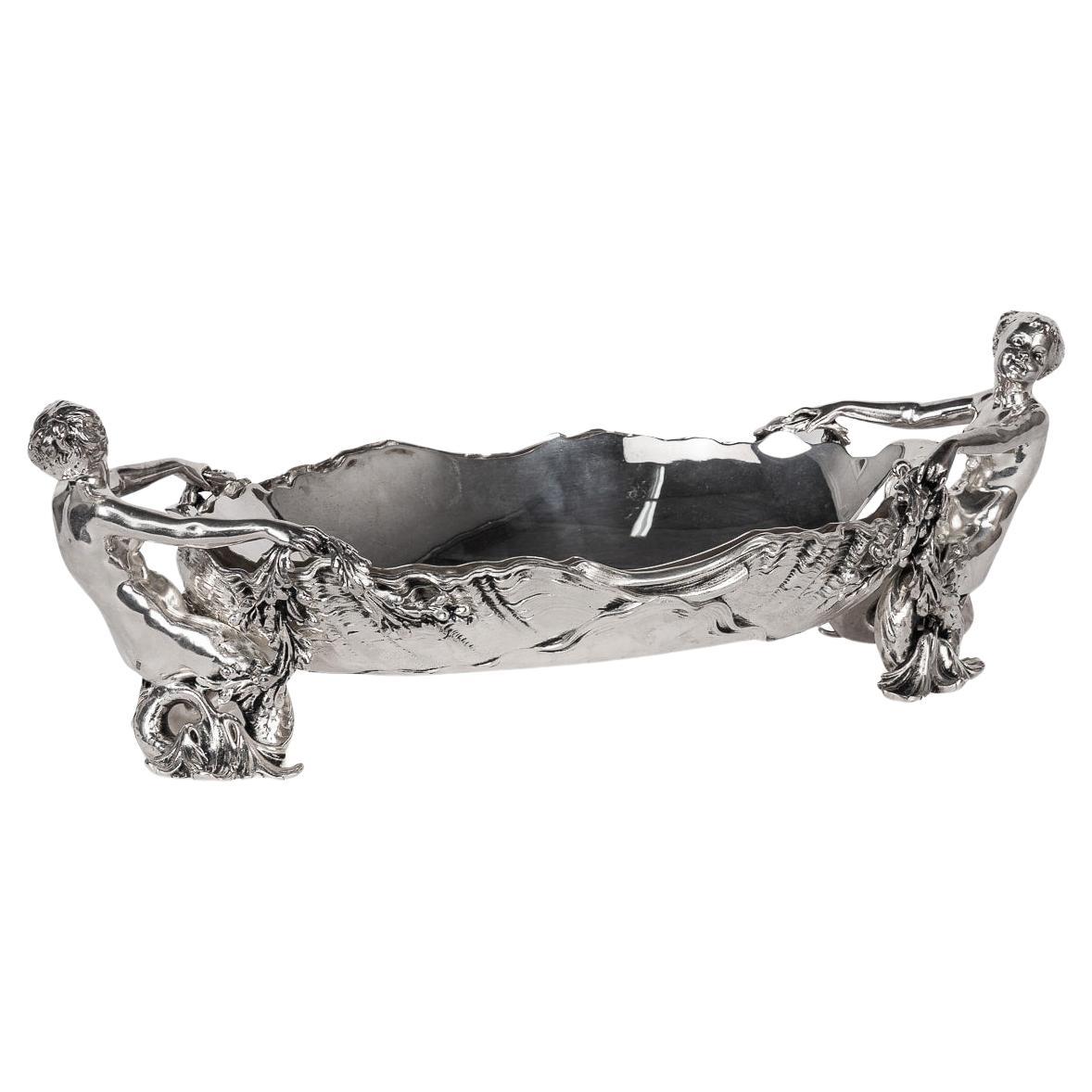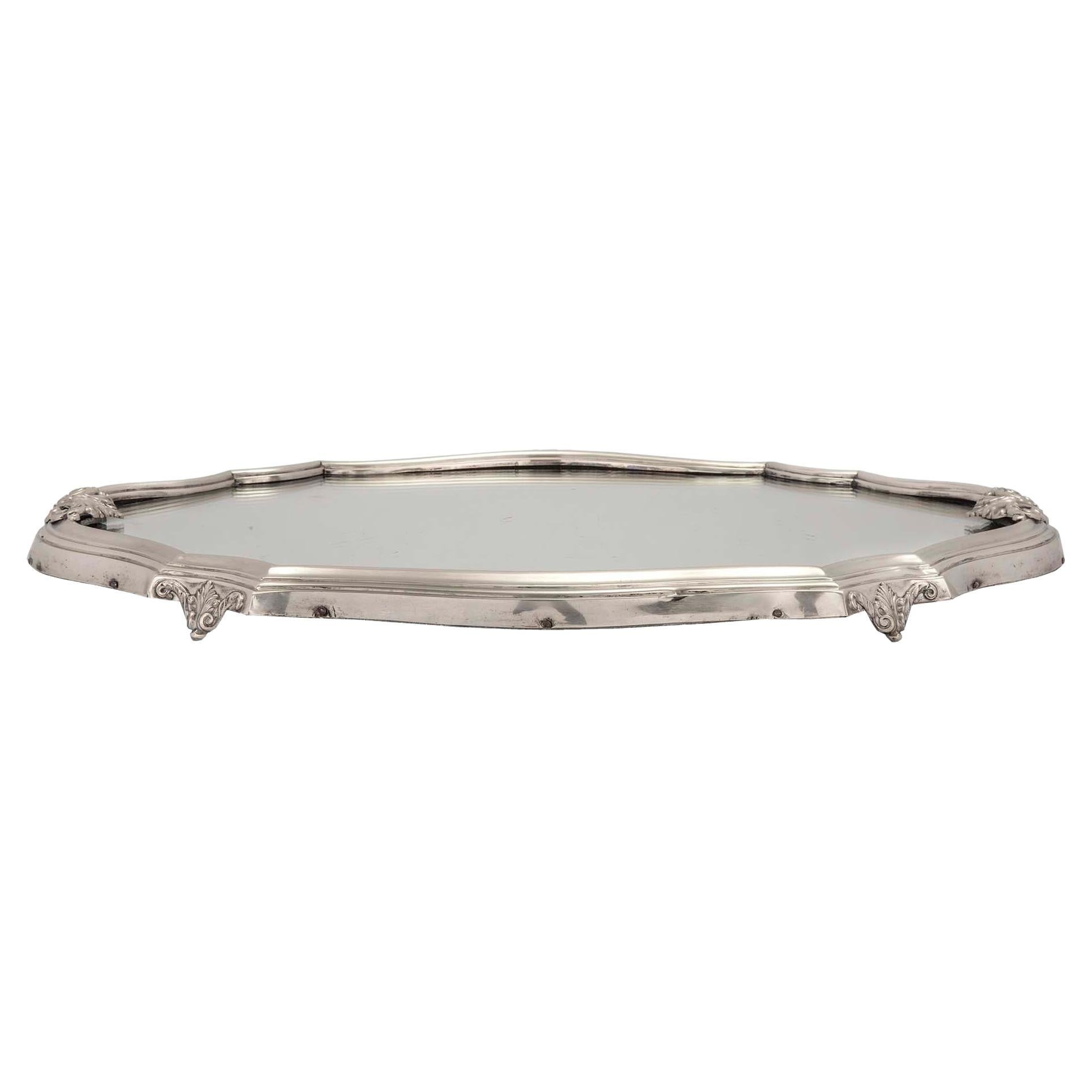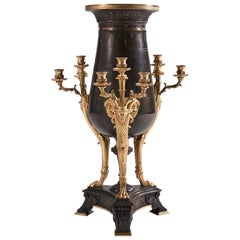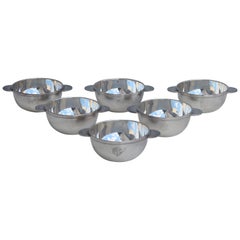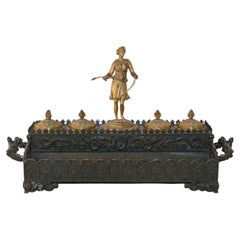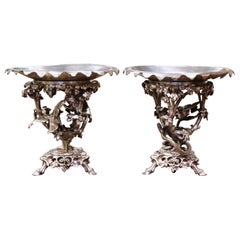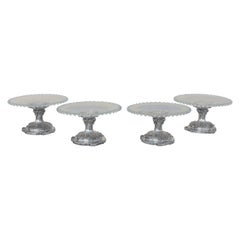
French 19th Century Silvered Bronze and Cristal Christofle Set of Centerpieces
View Similar Items
French 19th Century Silvered Bronze and Cristal Christofle Set of Centerpieces
About the Item
- Creator:Christofle (Maker)
- Dimensions:Height: 5.91 in (15 cm)Diameter: 10.63 in (27 cm)
- Sold As:Set of 4
- Style:Louis XV (In the Style Of)
- Materials and Techniques:Bronze,Silvered
- Place of Origin:
- Period:
- Date of Manufacture:circa 1890
- Condition:
- Seller Location:Saint-Ouen, FR
- Reference Number:1stDibs: LU2612317004222
Christofle
Although he started his career as a jeweler in 1830 — after apprenticing with his copper jeweler brother-in-law years earlier — Charles Christofle (1805–63) recognized that Second Empire France had an untapped audience for luxury silverware and tableware.
Gold and silver gilt had been the high-end standard in the 18th century, yet society after the Industrial Revolution demanded a more affordable, but still refined, approach. So in the 1840s, Christofle cornered the market on electrolytic gilding and silver plating, dominating the hold on patents in the country for over a decade. His work soon attracted the attention of Louis-Philippe I and then Napoleon III, under whom he was named Fournisseur de l’Empereur, cementing the prestige of his brand.
While Christofle created decadent centerpieces and tableware for the French palaces — as well as prominent clients like the Orient Express — the company’s electroplating of silverware that was far less expensive than that made by silversmiths attained widespread popularity. At a time when many who could not afford gold or silver still used wooden utensils, Christofle was a game changer for at-home dining. An appearance at the 1893 World’s Columbian Exposition in Chicago furthered the company’s reach to American consumers who would soon rival the manufacturer’s European clientele.
The 20th century saw Christofle adapting to changing tastes in its offerings, such as the Aria collection, which debuted in 1985 with column-like lines on its flatware designed by Bernard Yot, and the playful egg-shaped silverware container introduced in 2015 that opens to reveal a full flatware set. The company also now sells barware, home accessories and even jewelry, harkening back to its roots. Now almost two centuries old, Christofle maintains its reputation as a leading flatware and silverware company under the ownership of the Chalhoub group, its utensils gracing tables in homes, hotels and restaurants all over the world.
Shop authentic Christofle serveware, ceramics, decorative objects and more on 1stDibs.
- Impressive French 19th Century Neo-Greek Style Bronze Nine-Lights CenterpieceBy Georges Emile Henri ServantLocated in Saint-Ouen, FRAn impressive French 19th century Neo-Greek style bronze nine-lights center piece In patinated and gilt bronze, engraved on the body of foliage and rings, the collar decorated with a frieze of palms in bas-relief. It is held by a tripod base decorated with shards, foliage, and fins, in the center a mask of man. Surmounted by three arms, nine-lights ending in lion’s paw. Curved triangular base with ivy friezes, and palm-leaf feet. Attributed to Georges Emile Henri...Category
Antique 1860s French Napoleon III Vases
MaterialsBronze
- Luc Lanel & Christofle for Compagnie Générale Transatlantique a Set of Six CupsBy ChristofleLocated in Saint-Ouen, FROrfèvrerie Christofle for "Ile de France" 1949 Compagnie Générale Transatlantique Paquebot A set of six silvered metal cups Monogr...Category
Vintage 1940s French Art Deco Tableware
MaterialsMetal
$2,720 Sale Price / set20% Off - French 19th Century Neogothic InkwellLocated in Saint-Ouen, FRDiana the Huntress A Louis Philippe Neo-Gothic Style Ormolu Inkwell Rectangular in brown patina bronze and gilt bronze. The tier presents in its center a statuette of Diana the ...Category
Antique 1850s French Napoleon III Inkwells
MaterialsBronze, Ormolu
- French 19th Century Pair of Porcelain Cache-PotsLocated in Saint-Ouen, FRPair of polychromed hand painted porcelain with Japonisme floral decoration Ormolu-mounted with open-worked base and rim Louis XVI Style circa 1880.Category
Antique 1870s French Chinoiserie Planters, Cachepots and Jardinières
MaterialsOrmolu
$1,921 Sale Price / set20% Off - French 19th Century Pair of Lacquered Bamboos Japonisme VasesBy Edouard Lievre, Ferdinand BarbedienneLocated in Saint-Ouen, FRA 19th French century pair of Lacquered Bamboos Japonisme vases. An amazing pair of tall cylindrical bamboo vases decorated in Japanese Gold and Sil-ver Hiramaki-E Lacquer with Pavilions in The Mist and Weaving Figures, Flown Over by a Pair of Cranes. Enclosed in a Sino-Japanese Inspiration Golden and Brown Patina Bronze Mount Featuring Elephant Heads, Partially Openwork Branches and Salamanders Forming Side Handles. Circa 1870 Attributed to Édouard Lièvre (1828-1886) and Ferdinand Barbedienne (1810-1892) Édouard Lièvre (1828-1886) is one of the most talented and prolific designer and industrialist of the 19th Century, his repertoire is sometimes Sino-Japanese or Neo-Renaissance, whether in furniture or works of art, we can note in particular the parade bed of Valtesse de La Bigne, furniture commissioned by the painter Édouard Detaille or even Sarah Bernhardt, and the famous works in collaboration with Maison Christofle or those in gilded bronze and cloisonné enamel edited by Ferdinand Barbedienne, presented at the Universal Exhibitions in 1878, 1889 and 1900. He was both a draftsman, painter, illustrator, engraver, ornamentalist and cabinetmaker, first trained in the studio of the painter Thomas Couture, Lièvre was then fully immersed in the world of decoration, creation and ornamentation and provides designs for manufacturers and merchant-publishers. Often assisted by his brother Justin, he first produced works of art for his own apartment, seeking out the finest craftsmen to execute his designs for bronzes, ceramics, fabrics and luxury furniture from great virtuosity and great taste. He then collaborated with the cabinet-maker Paul Sormani, as well as haberdasher merchants such as the Escalier de Cristal, bronziers such as Maison Marnyhac and especially Ferdinand Barbedienne as on our vases with bronze mounts characteristics of Edouard Lièvre's work. Born in 1810, died in Paris in 1892, Ferdinand Barbedienne, the most important caster of bronze pieces of art during the second half of the 19th Century, created and directed in Par-is one of the major artistic foundries of his time. Barbedienne specialized in classical reproductions, whose models were exposed in famous European museums. Their illustrated catalogues included many diverse objects such as busts, ornemental sculpture (clocks, candelabras, cups) sometimes even life-sized and bronzes for furniture. Apart from his own produc-tion, Barbedienne worked for the most renowned sculptors such as Barrias, Clésinger and Carrier-Belleuse. All his works were highly esteemed and he, himself honored by contemporary critics. At the London exhibition in 1851 Barbedienne’s firm won two « Council medals ». At the 1855 Universal Exhibition, he won a medal of honor. The success of Barbedienne’s firm brought him many official commissions, such in about 1860, as Barbedienne supplied bronzes for furniture for the Pompeian Villa of Prince Napoléon-Joseph, located avenue Montaigne in Paris. At the London Universal Exhibition of 1862 Barbedienne won medals in three different categories: Furniture, Silversmith work and Artistic bronzes. Barbedienne was made an officer of the Légion d’Honneur in 1867 and Commander in 1878 when he was compared with « a prince of industry and the king of bronze casting ». His glory did not decline with the passage of the time for at the Universal Exhibition of 1889 the critics thanked Barbedienne for the example he set for other bronze-casters by the perfection of his bronzes. “Japonisme” in the second half of the 19th century, was a craze for everything that came from Japan or imitated its style. The word was first coined in a series of articles published by Philippe Burty, from May 1872 to February 1873, in the French magazine “la Renaissance Littéraire et Artistique”. Far from the Academic sphere, artists seeking for new ways of expression, appropriated this discovery. Manet and the impressionists led the way to half a century of enthusiasm for Japanese art, and largely contributed to the esthetical revolution Europe experienced between 1860 and the beginning of the twentieth century. From 1862, The World’s Fairs provoked massive arrivals of fans, kimonos, lacquers, bronzes, silks, prints and books that launched the real era of Japonisme. With those exhibitions, the demand was boosted, the number of merchants and collectors was multiplied, and artists became passionate about this new esthetic. For them, its “primitivism” was probably its most important quality: artists were fond of the Japanese art’s capacity to be close to nature and to reconcile art and society by representing, with a lot of care, the most trivial objects. In painting, Edouard Manet, Mary Cassatt, Degas, Van Gogh, Gauguin were among those who were deeply inspired by Japanese art, affected by the lack of perspective and shadow, the flat areas of strong color, the compositional freedom in placing the subject off-center, with mostly low diagonal axes to the background. The Japanese iris, peonies, bamboos, kimonos, calligraphy, fish, butterflies and other insects, the blackbirds, cranes and wading birds, the cats, tigers, and dragons were endless sources of inspiration, appropriation, and reinterpretation for European artists. The occidental productions were combining styles and artistic conceptions instead of copying Japanese art slavishly. That is what brings to light the comparison between the artworks of Kitagawa Utamaro and Degas, of Katsushika Hokusai and Van Gogh The World’s Fairs of 1851 and 1862 in London, those of 1867, 1878, 1889 and 1900 in Paris, of 1873 in Vienna and of 1904 in Saint Louis presented a number of “Japanese-Chinese” installations with earthenware, bronzes, screens and paintings and attracted the largest amounts of visitors In Vienna, the “Japanese village...Category
Antique 1870s French Japonisme Vases
MaterialsBronze
$42,250 Sale Price / set35% Off - 19th Century French Lacquered Wood ChandelierLocated in Saint-Ouen, FRA 19th century French polychromed lacquered wood eight-light chandelier Lacquered gloss cream wood with green, red and brown highlights Contained vase ending in foliated seed welcoming eight arms forming semicircles. The top has a frieze of red flowers in green interlacing and is topped with leaves and a painted egg cream...Category
Antique 1890s French Louis XVI Chandeliers and Pendants
MaterialsWood
$5,733 Sale Price30% Off
- Pair of 19th Century French Silvered Bronze Compotes Signed ChristofleBy ChristofleLocated in Dallas, TXDecorate a dining table or a buffet with this elegant pair of antique compotes. Crafted in France circa 1860 by renowned silversmith Christofle Company, each piece stands on three hoof feet over a grape and vine decorated base. The removable round plateau with scalloped edge sits on a pierced three branch with center bird nest top, decorated with foliage and acorns. One centerpiece features a bird defending her egg nest...Category
Antique Mid-19th Century French Centerpieces
MaterialsSilver Plate, Bronze
- French 19th/20th Century Louis XV Style Christofle & Cie Figural CenterpieceBy ChristofleLocated in Los Angeles, CAA very fine and palatial French 19th/20th century Christofle & Cie Louis XV style silvered figural centerpiece, fitted with an oval diamond-cut-glass center-dish, attributed to Bacca...Category
Antique Early 1900s French Louis XV Planters, Cachepots and Jardinières
MaterialsCrystal, Silver Plate, Bronze
$19,800 Sale Price20% Off - 19th Century Neoclassical Silvered Muses Centerpiece in the Manner of ChristofleBy ChristofleLocated in Los Angeles, CAA very fine French 19th century neoclassical style silver-plated figural centerpiece, in the manner of Christofle and a design by Mathurin Moreau (French, 1822-1912). The circular or...Category
Antique Early 1900s French Neoclassical Revival Centerpieces
MaterialsBronze
$4,950 Sale Price61% Off - Manner of Christofle 19th-20th Century Silver-Plated & Crystal Fruit CenterpieceBy ChristofleLocated in Los Angeles, CAA fine and rare 19th-20th century neoclassical Revival style silver plated metal and cut-glass centerpiece in the manner of Christofle. The boat-shaped ornately body with finely chas...Category
Antique Early 1900s Unknown Neoclassical Revival Centerpieces
MaterialsMetal
$3,950 Sale Price58% Off - Pair of 19th Century Cut-Glass and Silvered Bronze Compotes by ChristofleBy ChristofleLocated in London, GBPair of 19th century cut-glass and silvered bronze compotes by Christofle French, 19th Century Height 30cm, diameter 25cm Crafted in the lavish Rococo Revival style, this exquisit...Category
Antique 19th Century French Rococo Revival Centerpieces
MaterialsSilver Plate, Bronze
- French 19th-20th Century Louis XV Style Silvered Christofle & Cie CentrepieceBy ChristofleLocated in Los Angeles, CAA very fine and palatial French 19th-20th century Christofle & Cie Louis XV style silvered figural centrepiece with a cut-glass scalloped centre-dish, attributed to Baccarat, and fla...Category
Antique Early 1900s French Louis XV Centerpieces
MaterialsBronze
$14,950 Sale Price56% Off
